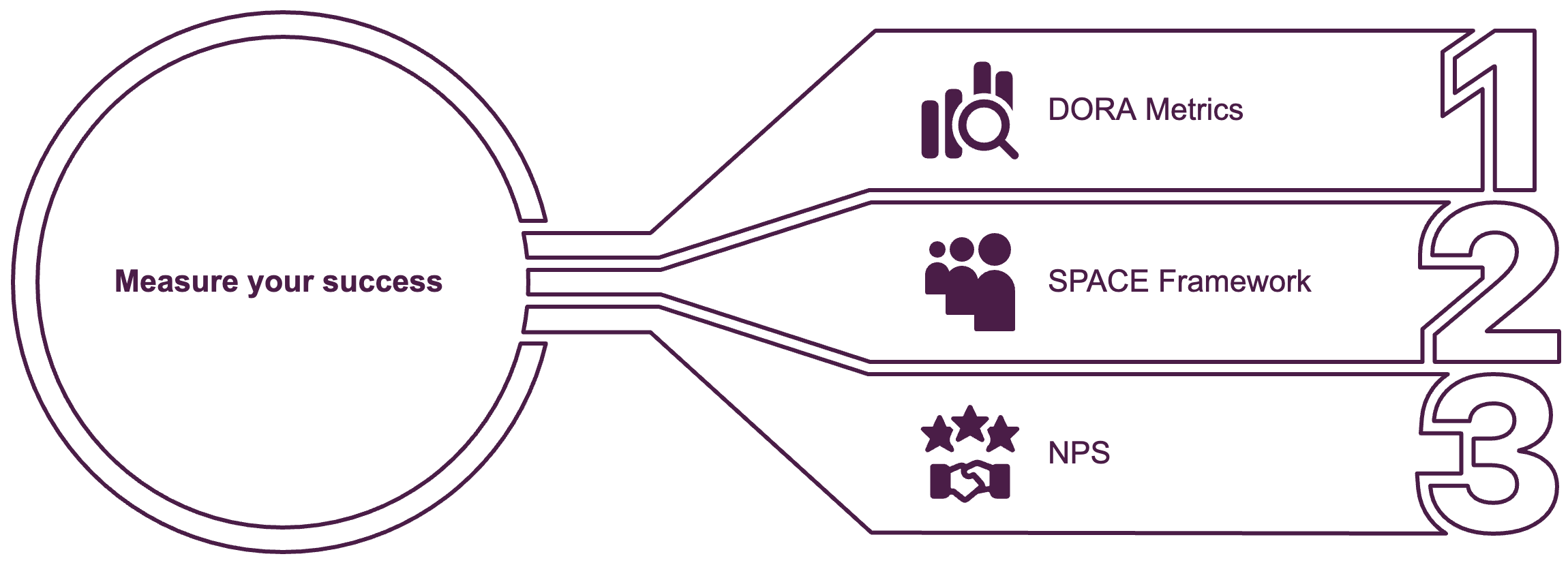With every initiative in an organisation, measuring the success of these initiatives is essential for stakeholders, consumers, and builders alike. Embracing the principle of “Platform as a Product”, consistent measurements drive the roadmap, aligns with stakeholder goals, evolves based on user feedback, and provides a great experience for consumers.
In the State of Platform Engineering Report Volume 3, in 2024, 44.67% of organisations surveyed stated that they do not measure any metrics to prove success in their Platform Engineering initiatives[1].
For that, I want to highlight some important metrics that can be measured to showcase your Platform Engineering initiative success.

DORA (DevOps Research and Assessment)
What is it?
Shows how organisations are currently performing and comparing them with industry benchmarks.
Which metrics are measured?
| DORA Metric | Description |
|---|---|
| Change lead time | The time it takes from code commit to production |
| Deployment frequency | How often new features or updates are released to production |
| Change fail percentage | How often a release causes issues in production |
| Failed deployment recovery time | How long it takes to fix the issue and get things running again in production |
How are these metrics measured?
Change lead time
Note down the time of pull request creation of a certain feature and then the time of deployment to production and calculate the difference. Aggregate the data to display a representative lead time.
Deployment frequency
Agree on what qualifies as a deployment (for example, a push or merge to master branch resulting in a deployment to the production environment) and use your CI/CD tool to count how many deployments occur per day, week, or month. Divide the total number of deployments made in a given time period over the total number of days in that period.
Change fail percentage
Agree on what qualifies a failure (for example, incidents occurring post deployment to production, rollbacks, or post-deployment bug tickets) and divide these occurrences over the total number of deployments over a certain period of time and multiply it by 100 to get the percentage.
Failed deployment recovery
Note down the time when a failure is detected, and then the time when the service is restored to normal and calculate the difference. Aggregate the data to display a representative recovery time.
What is the business impact?
| DORA Metric | Business impact |
|---|---|
| Change lead time | Enhanced flexibility and agility (for example, adapt quickly to regulatory changes) |
| Deployment frequency | Faster time-to-market |
| Change fail percentage | Sustained customer confidence and trust |
| Failed deployment recovery time | Strengthens organisational resilience and protects revenue streams by reducing downtime |
How does the Platform contribute?
| DORA Metric | Platform contribution |
|---|---|
| Change lead time | Automated testing environments, pre-baked CI/CD pipelines |
| Deployment frequency | Standardised release processes |
| Change fail percentage | Guardrails (for example, policy-as-code), built-in canary/blue-green deployments |
| Failed deployment recovery time | Centralised logging and metrics by default, integrated incident response tooling, rollback support baked into pipelines |

SPACE
What is it?
Provides a holistic way to understand how well your teams are doing.
Which metrics are measured?
| SPACE Metric | Description |
|---|---|
| Satisfaction and Wellbeing | How happy and engaged team members are in their work |
| Performance | How well a software system fulfils its intended functions |
| Activity | What work is being done and how often |
| Communication and Collaboration | How effectively team members and different teams interact, share ideas, and support one another |
| Efficiency and Flow | How smoothly work moves from start to final delivery |
How are these metrics measured?
Satisfaction and Wellbeing
- Conduct regular surveys focused on work-life balance, stress levels, and overall team morale.
- Hold one-on-one meetings and retrospectives where team members can voice their concerns.
- Ensure anonymity to encourage honesty and act on the insights to build trust and improve morale.
Performance
- Measure code quality and reliability, track bugs, and monitor service health.
- Use tools to monitor application performance in production.
- Review performance trends over multiple releases and hold post-mortems to learn from any issues.
Activity
- Perform code repository analysis for number of commits, number of code reviews completed, and deployment frequency.
- Focus on the quality and impact of the activity.
Communication and Collaboration
- Conduct surveys on cross-functional collaboration.
- Get feedback from team members on satisfaction around collaborative practices.
- Analyse communication channels for effectiveness.
Efficiency and Flow
- Use value stream mapping to visualise the complete process and identify stages causing delays.
- Monitor the frequency of hand-offs or rework as signals of process inefficiencies.
What is the business impact?
| SPACE Metric | Business impact |
|---|---|
| Satisfaction and Wellbeing | Higher employee retention and lower turnover |
| Performance | Improved quality and reliability, enhancing customer trust and satisfaction |
| Activity | Increased visibility, better planning, and reduced risk |
| Communication and Collaboration | Faster decision-making, reduced rework, and enhanced innovation |
| Efficiency and Flow | Faster time-to-market and reduced waste |
How does the Platform contribute?
| SPACE Metric | Platform contribution |
|---|---|
| Satisfaction and Wellbeing | Reduced cognitive load through standardisation, frictionless developer workflows |
| Performance | Built-in monitoring, alerting and tracing, easy access to service health dashboards |
| Activity | Automated reporting to reduce manual work, visibility into CI/CD activity, PRs, deployments |
| Communication and Collaboration | Centralised documentation, shared golden paths and templates |
| Efficiency and Flow | Streamlined onboarding, reduced hand-offs with self-service tooling |

NPS (Net Promoter Score)
What is it?
Helps measure employee satisfaction within an organisation. Using this method, we can measure the likelihood of a platform user recommending the platform to a colleague.
Which metrics are measured?
NPS is measured using a simple, one-question survey, along the lines of “on a scale of 0 to 10, how likely are you to recommend our platform to fellow developers or engineering colleagues?”.
How are these metrics measured?
- Responses are categorised into three categories – promoters (score 9-10), passives (score 7-8), detractors (score 0-6).
- The score is derived by subtracting the percentage of detractors from the percentage of promoters.
- You can use this calculator to calculate your NPS score.
What is the business impact?
- Increased developer productivity and efficiency translating into shorter development cycle times and higher ROI on the platform investment.
- Reduction in complexity through platform standardisation resulting in lower operational costs.
How does the Platform contribute?
| NPS focus area | Platform contribution |
|---|---|
| Likelihood to recommend the platform | Smooth onboarding, consistent and reliable experience |
| Promoter drivers (scores 9-10) | High perceived value, supportive platform team with clear feedback loops |
| Detractor signals (scores 0-6) | Frequent platform friction, poor documentation or onboarding |
| Action on NPS feedback | Continuous improvement based on survey results, building trust with users through responsiveness |
Other important metrics
Onboarding time
Measure the time required for a new joiner to create the 10th pull request.
Service create time
Measure the time required to get a service ready (including all resources and configurations) for deploying to production.

Conclusion
As shown above, having a solid setup of measuring these different metrics requires a lot of work and constant improvement. The earlier you can start measuring these metrics, the faster you can show value to your stakeholders and gain traction with your initiative.
With only almost 10.42% of organisations having a comprehensive mechanism providing insights that can help in data-driven decision making, we have a long way to go until organisations reach this point[1].
References
[1] https://platformengineering.org/reports/state-of-platform-engineering-vol-3
https://dora.dev/guides/dora-metrics-four-keys
https://getdx.com/blog/space-metrics
First Photo by Napkin AI
Second Photo by Edvin Richardson
Third Photo by Meruyert Gonullu
Fourth Photo by Burak The Weekender




